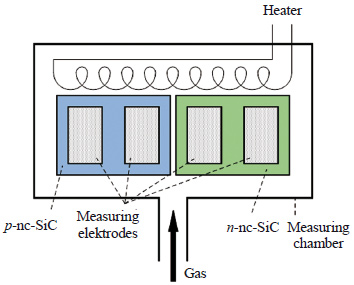Новий підхід до підвищення чутливості газового сенсора на основі плівок нанокристалічного карбіду кремнію
Анотація
Останнім часом гостро стоїть проблема пошуку нових функціональних напівпровідникових матеріалів для створення високочутливих газових сенсорів, які слабо змінюють свої властивості в умовах жорстких зовнішніх впливів. Завдання поліпшення характеристик газочутливих матеріалів постійно знаходяться в центрі уваги розробників приладів. Наноструктуровані SiC матеріали, при більш низькій вартості, проявляють високу стабільність властивостей і підвищену газову чутливість в порівнянні з об'ємними SiC матеріалами, завдяки значно більшій площі поверхні взаємодії з аналізованих газом.
У роботі досліджено можливість збільшення чутливості газового сенсора на основі плівок нанокристалічного SiC, шляхом використання схеми двох компонентного чутливого елемента, один з яких є плівка n-nc-SiC з електронною провідністю, а другий плівка p-nc-SiC з дірковою провідністю. Завдяки протилежній полярності зміни опору під час дії газу різниця між величинами зміни відносних опорів плівок n-nc-SiC та p-nc-SiC завжди буде більше, ніж у кожній плівці окремо. Встановлено доцільність використання двокомпонентного чутливого елемента газового сенсора на основі плівок nc-SiC з електронною та дірковою провідностями. Двокомпонентний газовий сенсор з підвищеною чутливістю на основі nc-SiC плівок може бути основою лінійки нових приладів для аналізу агресивних газів в екстремальних умовах.
Посилання
Mehmood F., Ahmad S., Kim D.H. Design and implementation of an interworking IoT platform and marketplace in could of things. Sustainability, 2019, vol. 11, iss. 21, p. 5952. https://doi.org/10.3390/su11215952
Arafat M., Haseeb A.S.M.A., Akbar S.A. Quadir M.Z. In-situ fabricated gas sensors based on one dimensional core-shell TiO2-Al2O3 nanostructures. Sensors and Actuators B: Chemical, 2017, vol. 238, pp. 972-984. https://doi.org/10.1016/j.snb.2016.07.135
Jaisutti R., Lee M., Kim J. et al. Ultrasensitive room-temperature operable gas sensors using p-type Na: ZnO nanoflowers for diabetes detection. ACS Applied Materials & Interfaces, 2017, vol. 9, iss. 10, pp. 8796-8804. https://doi.org/10.1021/acsami.7b00673
Wu J., Tao K., Guo Y. et al. A 3D chemically modified graphene hydrogel for fast, highly sensitive, and selective gas sensor. Advanced Science, 2016, vol. 4, iss. 3, pp. 1-9. https://doi.org/10.1002/advs.201600319
Song Z., Wei Z., Wang B. et al. Sensitive room-temperature H2S gas sensors employing SnO2 quantum wire/reduced graphene oxide nanocomposites. Chemistry of Materials, 2016, vol. 28, iss. 4, pp. 1205-1212. https://doi.org/10.1021/acs.chemmater.5b04850
Hien H.T., Giang H.T., Hieu N.V. et al. Elaboration of Pd-nanoparticle decorated polyaniline films for room temperature NH3 gas sensors. Sensors and Actuators B: Chemical, 2017, vol. 249, pp. 348-356. https://doi.org/10.1016/j.snb.2017.04.115
Mun S., Park Y., Lee Y.K., Sung M.M. Highly sensitive ammonia gas sensor based on single-crystal poly(3-hexylthiophene) (P3HT) organic field effect transistor. Langmuir, 2017, vol. 33, iss. 47, pp.13554-13560. https://doi.org/10.1021/acs.langmuir.7b02466
Capano M.A., Trew R.J. Silicon carbide electronic materials and devices. MRS Bulletin, 1997, vol. 22. iss. 3, pp. 19-23. https://doi.org/10.1557/S0883769400032711
Spetz A.L, Savage S. Advances in SiC field effect gas sensors. In: Choyke W.J., Matsunami H., Pensl G. (eds) Silicon Carbide. Recent Major Advances, Germany, Berlin, Springer, 2004, pp. 869-896. https://doi.org/10.1007/978-3-642-18870-1_36
Zolper J.C., Skowronski M. Advances in silicon carbide electronics. MRS Bulletin, 2005, vol. 30, iss. 4, pp. 273-278. https://doi.org/10.1557/mrs2005.73
Neudeck P.G., Okojie R.S., Chen L. High-temperature electronics - a role for wide bandgap semiconductors? Proceedings of the IEEE, 2002, vol. 90, iss. 6, pp. 1065-1076. https://doi.org/10.1109/JPROC.2002.1021571
Gaiardoa A., Belluttib P., Fabbria B. et al. Sensing properties of nanocrystalline silicon carbide in wet condition. 17th IMCS University of Vienna, 2018, Austria, pp. 612-613. https://doi.org/10.5162/IMCS2018/P1NM.18
Sultan A., Ahmad S., Mohammad F. A highly sensitive chlorine gas sensor and enhanced thermal DC electrical conductivity from polypyrrole/silicon carbide nanocomposites. RSC Advances, 2016, vol. 6, pp. 84200-84208. https://doi.org/10.1039/C6RA12613H
Semenov A.V., Puzikov V.M., Dobrotvorskaya M.V. et al. Nanocrystalline SiC films prepared by direct deposition of carbon and silicon ions. Thin Solid Films, 2008, vol. 516, iss. 10, pp. 2899-2903. https://doi.org/10.1016/j.tsf.2007.05.059
Kozlovskyi A., Semenov A., Skorik S. Electron transport in nanocrystalline SiC films obtained by direct ion deposition. Superlattices and Microstructures, 2016, vol. 100, pp. 596-604. https://doi.org/10.1016/j.spmi.2016.10.013
Semenov A., Kozlovskyi A., Skorik S., Lubov D. Gas sensing properties of nanocrystalline silicon carbide films. Micro and Nano System Letters, 2019, vol. 7, iss. 6, pp. 1-5. https://doi.org/10.1186/s40486-019-0084-7
Semenov A.V., Lubov D.V., Kozlovskyi A.A. The Chemresistive properties of SiC nanocrystalline films with different conductivity type. Journal of Sensors, 2020, аrticle ID 7587314, pp. 1-6. https://doi.org/10.1155/2020/7587314
Taki Y., Kitiwan M., Katsui H., Goto T. Electrical and thermal properties of off-stoichiometric SiC prepared by spark plasma sintering. Journal of Asian Ceramic Societies, 2018, vol. 6, iss. 1, pp. 95-101. https://doi.org/10.1080/21870764.2018.1446490
Gadzira M., Gnesin G., Mykhaylyk O. et al. Solid solution of carbon in β-SiC. Materials Letters, 1998, vol. 35, iss. 5-6, pp. 277-282. https://doi.org/10.1016/S0167-577X(97)00263-2
Semenov A.V., Puzikov V.M., Golubova E.P. et al. Low-temperature production of silicon carbide films of different polytypes. Semiconductors, 2009, vol. 43, iss. 5, pp. 685-689. http://dx.doi.org/10.1134/S1063782609050273
Birnie, D. P., & Kingery, W. D. , The limit of non-stoichiometry in silicon carbide. Journal of Materials Science, 1990, vol. 25, iss. 6, pp. 2827-2834. https://doi.org/10.1007/bf00584888
Platzek D., Karpinski G., Stiewe C. et al. Potential-Seebeck-microprobe (PSM): measuring the spatial resolution of the Seeb.eck coefficient and the electric potential. ICT 2005. 24th International Conference on Thermoelectrics. https://doi.org/10.1109/ICT.2005.1519875
Cheong K.Y., Silicon carbide (SiC) as non-volatile random access memory (NVRAM) material. JURUTERA, 2005, pp. 10-16.
Yoon J.W., Kim H.J., Jeong H.M., Lee J.H. Gas sensing characteristics of p-type Cr2O3 and Co3O4 nanofibers depending on inter-particle connectivity. Sensors and Actuators B: Chemical, 2016, vol. 202, pp. 263-271. http://dx.doi.org/10.1016/j.snb.2014.05.081
Nikolic M.V., Milovanovic V., Vasiljevic Z.Z., Stamenkovic Z. Semiconductor gas sensors: materials, technology, design, and application. Sensors, 2020, vol. 20, iss. 22, 6694. https://doi.org/10.3390/s20226694
George F.F., Leon M.C., Ayo A., Russell B. Metal oxide semi-conductor gas sensors in environmental monitoring. Sensors, 2010, vol. 10, iss. 6, pp. 5469-5502. https://doi.org/10.3390/s100605469
Semenov A.V., Lubov D.V., Makhonin M.V., Ozone Sensitive Properties of Thin Films of Nanocrystalline Silicon Carbide. Journal of Nano- and Electronic Physics, 2020, vol. 12, iss. 5, p. 05016. https://doi.org/10.21272/jnep.12(5).05016
Hall S.A. Airborne contaminants. Occupational Health Practice, 1973.

Авторське право (c) 2021 Semenov A., Lubov D.

Ця робота ліцензується відповідно до Creative Commons Attribution 4.0 International License.
